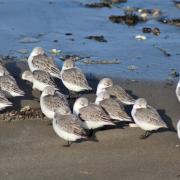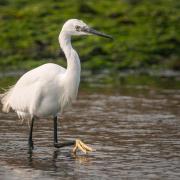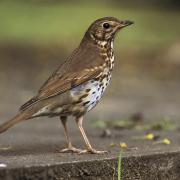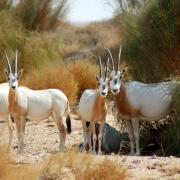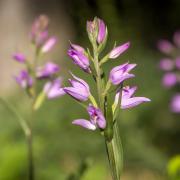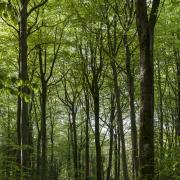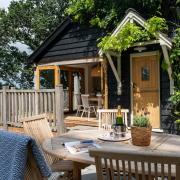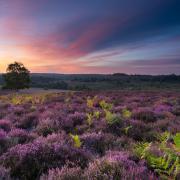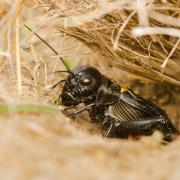Hidden deep within The New Forest, Liberty’s Owl, Raptor and Reptile Centre is ready to delight with its collection of stunning birds of prey

Whoosh! Feathers brushed against my cheek and air fanned my face. Sugar Puff or perhaps Pipsqueak, one of the pair of Siberian Eagle Owls, had swooped low and I was in the way.
Half an hour earlier, I’d joined the other visitors to Liberty’s Owl and Raptor Centre near Ringwood for a bird of prey flight demonstration in the flying field. Vultures, Owls, Hawks and a Striated Caracara each took their turn to display their distinctly different styles. Sugar Puff and Pipsqueak are brother and sister and the largest species of owl in the world. Their handler, head falconer John Picton warned us that these birds may swoop on an unsuspecting mammal that strays into their sightline; a good reason why dogs are not allowed into the centre.
Lynda Bridges took over the centre nine years ago and poured everything she had into it; her home, savings, pension plans and most especially, her spirit.
“I didn’t buy a single stitch of clothing for a whole year. I was determined to save the animals and run a successful business.”

Lynda has the spirit of an eagle and despite almost two years of planning refusals and expensive legal dealings, once she got her talons into this project, there was no letting go.
We sat in the café drinking tea and nibbling homemade coffee and walnut cake while she told me her story. A one time chicken farmer, teaching assistant and Christmas tree grower, Lynda is now in to her seventh year of business at Liberty’s; and there has been a lot of improvements during that time. She’s reduced the number of aviaries and doubled the size of many.
“It’s not that the birds need more space, it makes the public more comfortable. John has probably told you that birds of prey are happy to laze about. They only fly when they need to find food, and we make life easy for them by providing regular meals.”
“Food?” I asked, thinking back to the harvest mice enclosure I’d seen earlier. Lynda reassured: “We buy the meat in for the birds from frozen. The mice are for releasing into the wild once we get a breeding programme up and running. I had to put up a sign so that visitors would stop worrying.”
Liberty’s holds a Zoo license, which means that Lynda has to offer conservation, preservation, research and education. She loans her birds out to breeding programmes around the world and has supported local students wanting to further their studies.
The Falconers
John Picton is the head Falconer and lives on site. He was trained by his father and handled his first bird at the age of four. He spent six months in Africa working with birds and says that 80% of the world’s birds of prey come from that continent. He’s 28 now and passionate about Vultures and their importance to the ecosystem.
“They are nature’s dustbin and are divided into New World and Old World groups. There aren’t any that are on the safe list,” he said, with an air of concern.
“They keep diseases from spreading by scavenging on rotting carcasses. The highest recorded flight by a bird was made by a Ruppell’s Griffon, a vulture with a wingspan of about 10 feet; and in 1975, one was sucked into a jet engine 37,900 feet above the Ivory Coast. (That’s more than a mile and a half higher than the summit of Mount Everest.) Thankfully the plane landed safely.” I could have listened to John talk all day, his enthusiasm is infectious and together with Lynda’s son Jayson – the pair make a great team.
At 15, Jayson was the youngest display falconer in the UK. Nowadays, he enjoys going to outside events at fairs, schools and private shows. You may spot him out and about on bird control missions too, there’s no better deterrent for feral pigeons than a hovering hawk.
Both John and Jayson are brilliant role models for any young visitors as Jayson explains: “Young lads come here and see us and think, oh, I can still love animals and not lose my street cred. We hope we can educate in a non-educational way.”
Looking after 130 birds made up of 55 species requires specialist skills, including the provision of physiotherapy for Chaplin, a disabled Spectacled Owl.
“I love what I do,” said John, beaming from ear to ear. “I came here on work experience and never left.”
Off the scale
For Lynda, it is not so much the feathered friends that she enjoys the company of, but the cold-blooded residents who have made a home at Liberty’s, such as the Bearded Dragon and the Burmese Python.
The reptile zone is climate controlled and immaculately kept. Of the thirty odd species, the Giant Day Gecko from Madagascar was my favourite. Apple green with a red stripe extending from nostril to lidless eyes, you’re never sure if he’s awake or asleep.
“Most are here because their original owners bought them as pets and got bored, or in the case of Stormin Normin, a Giant African Tortoise, simply got too big”, Lynda explained as we wandered between the various enclosures. I worried that some of them might be a bit lonely on their own behind the glass, but Lynda assured me that reptiles are mostly solitary animals, until it is time to find a mate.
Fly, Hunt or Shoot
Liberty’s run various experience days where you can get up close and personal with the birds. Enjoy a short day practising the ancient sport of Falconry including handling, manning and training on their Falconry Experience Flying Day; priced at £65 for ages 10 to 15 and £95 for over 16s.
For those who’d like to try a spot of Hawking, head out to the surrounding countryside with one of the centre’s trained falconers to see what these birds can really do; priced at £65 for over 16s only. Or for the photographers amongst you, capture these magnificent birds in the natural setting of the New Forest and take home a moment to treasure forever; prices start at £45 for a day shoot or £250 for a private photographing experience for up to five people.
Getting there
• Detailed directions can be found online at www.libertyscentre.co.uk.
• Sat Nav Postcode: BH24 3EA
• Open weekends only from November to February from 10am to 4pm (last admission 3pm). There is a café and gift shop onsite.
• Admission charges: Adults £8.95, Seniors £7.95, Child 5-15 £5.95 and Family of four £27.50.
• Liberty’s Owl, Reptile & Raptor Centre
• Crow Lane, Ringwood; 01425 476487
--------------------------------------------------
Read on
• 4 ways to help Hampshire bees get through the winter• Nocturnal wildlife to look out for in Hampshire• CLA Chairman on why we need to protect farmland birds






